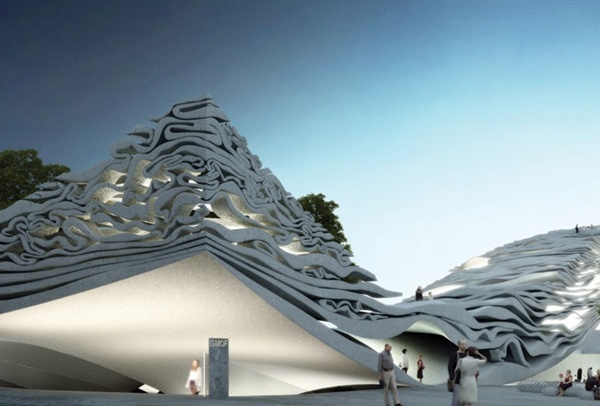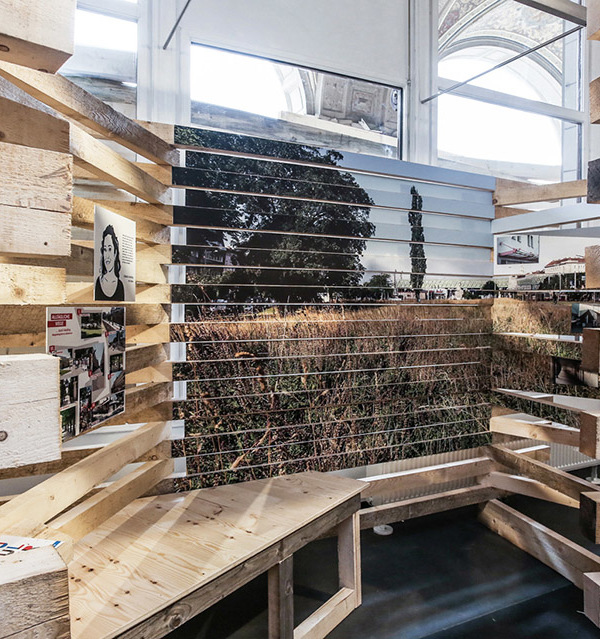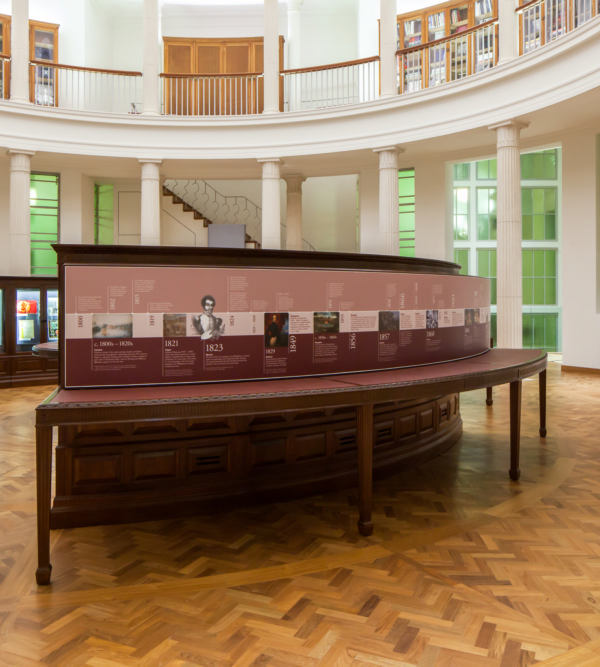© Hermant Chawla
c Hermant Chawla
架构师提供的文本描述。“博努尔印度体验”(Bonjour India Experience)是Bonjour India 2017-2018艺术节的旗舰项目,这是一个庆祝印度支那与法国合作的节日,历时4个月,在印度33个城市举办了300多场活动。在艺术节的核心,博努尔印度体验馆是艺术、建筑、设计和都市主义交汇处的独一无二的旅游展览。这座9米高、800平方米和40吨的装置行驶了大约。距离德里标志性的印度门3500公里,到历史悠久的孟买教会门站后面的十字广场花园,三个月内成为加尔各答世界上最大书展的明星景点。在这三个城市30多天的时间里,它接待了超过18万名游客。
Text description provided by the architects. The ‘Bonjour India Experience’ was the flagship initiative of the Bonjour India 2017-2018, a festival which celebrated Indo-French collaborations through more than 300 events spread over four months across 33 Indian cities. At the heart of the festival, The Bonjour India Experience pavilion was a one-of-its-kind travelling exhibition at the intersection of art, architecture, design and urbanism. The 9 meter high, 800 square metre and 40 tonne installation travelled approx. 3500 kilometres from the iconic India Gate in Delhi to Cross Maidan Garden behind the historic Churchgate Station Mumbai to become the star attraction of the world’s largest book fair in Kolkata over a period three months. It welcomed more than 180,000 visitors over a period of 30 odd days spread over the three cities.
© Hermant Chawla
c Hermant Chawla
由客户和SpaceMatters领导的设计团队共同作出的第一批决定之一是将展馆定位于公共城市空间。虽然这似乎是一个显而易见的选择,但印度类似的文化活动大多局限于博物馆和文化中心等体制空间。这些空间往往被认为是精英主义者,迎合了一小部分人口,他们的氛围与印度城市中城市公共空间的多样化能量形成鲜明对比。随着文化活动退回到封闭区域,印度城市公共空间的通道也在缩小,越来越多地受到监管和货币化。因此,当被要求在他们的城市建议一个合适的公共空间时,合伙人们最初建议商业购物中心!呼吁将展馆定位于真正公共的城市空间带来了无数的挑战,在公共地点安装这种规模的设备所需的迷宫许可是一项复杂的任务。然而,它与城市环境的互动成了展馆的决定性特征,有助于它的成功。
One of the first decisions jointly taken by the clients and the design team lead by SpaceMatters was to locate the pavilion in public urban spaces. While this may seem like an obvious choice, similar cultural events in India have been largely confined to institutional spaces such as museums and cultural centres. Often perceived as elitist, these spaces cater to a small segment of the population and their ambience is in stark contrast to the diverse energy of the urban public space in Indian cities. As cultural events retreat into gated zones the access to public space in Indian cities is also shrinking, increasingly being policed and monetised. Thus, when asked to suggest an appropriate public space in their city, associates initially suggested commercial malls! The call to locate the pavilion in truly public urban spaces presented countless challenges and it was a complex undertaking to navigate the maze of permissions needed to mount an installation of this scale in a public location. However, its interaction with the urban context became the defining characteristic of the pavilion and was instrumental to its success.
© Hermant Chawla
c Hermant Chawla
© Hermant Chawla
c Hermant Chawla
设计必须平衡旅游馆的功能需求和密封展览空间的严格要求,以便安全地容纳昂贵的视听设备,同时为游客创造一个舒适的环境。展馆的设计必须在一周内安装,并在三天内在拥挤的公共场所拆除,不使用重型机械(在高度安全的地点禁止使用);便于在全国各地旅行,并适应新的地点。为了调和展馆的移动性和时代性,以及在其前往的城市留下令人难忘的印记的雄心,该展馆必须创造一种标志性的视觉存在和轻盈的存在。
The design had to balance the functional demands of a travelling pavilion with the stringent requirements of a sealed exhibition space required to safely house expensive audio visual equipment while creating create a comfortable environment for the visitors. The pavilion had to be designed to be installed in a week and dismantled in three days in crowded public spaces without the use of heavy machinery (prohibited at the high security sites); with the ease of travelling halfway across the country and adapting to new sites. To reconcile the mobile and temporal nature of the pavilion alongside the ambition to leave a memorable mark on the cities it travelled to, the pavilion had to create an iconic visual presence combined with a lightness of being.
© Hermant Chawla
c Hermant Chawla
© Hermant Chawla
c Hermant Chawla
Bonjour印度节的主题重点是印度和法国之间的“创造力、创新和伙伴关系”。体现了这些主题,展馆的形式从汇合点的思想演变而来,6条曲线一起上升,包含三个展馆,突出了英法两国创造力和创新的各个方面。
The thematic focus of the Bonjour India festival was ‘Creativity, Innovation and Partnership’ between India and France. Embodying these themes, the form of the pavilion evolved from the idea of confluence, with 6 curves rising together to embrace three pavilions that highlight various aspects of Indo-French creativity, innovation & partnership. The metal curves, arranged in a modular symmetry spiralling out from a central core, consisted of a rhythmic arrangement of staggered, self-supporting steel members draped with 20,000 square feet of hand woven steel mesh. The massive self-supporting structure is designed down to the last joint to be flat packed and largely hand installed in the shortest possible time. Combining the precision of cutting edge engineering and unique expression of craft, the design pays homage to the ingenuity and abstraction that is the hallmark of both French and Indian architecture.
© Hermant Chawla
c Hermant Chawla
作为对公共空间的一种干预,该展馆的设计目的是将自己与每个地点的场地条件结合起来。金属构件和网眼提供了不同等级的视觉渗透性,使结构能够编织到城市环境中,无论是从环境中出现还是在环境中融合。每个景点的标志性纪念碑,如德里的印度门和孟买的丘尔盖特铁路终点站,都是由结构轮廓和铁丝网的分层轮廓构成的。当展馆日夜随着光线的作用而变换时,它螺旋式的形状就成了重新组织城市开放地区性质的枢纽,同时也增强了外界探索的好奇心。从四周4米到9米的扭曲和旋转,展馆的雕塑形式随着游客在展馆周围行走和进入展馆而发生了运动的变化。
As an intervention in public space the pavilion is designed to integrate itself with the site conditions at each location. The metal members and mesh provide for varying gradations visual permeability, allowing the structure to weave into the urban surroundings, both emerging from and merging into the context. Views of iconic monuments at each site, such as the India Gate in Delhi and the Churchgate Railway Terminus in Mumbai are framed within the layered silhouette of the structural contours and wire mesh.As the pavilion transforms with the play of light through day and night, its spiralling form becomes the pivot which reorganises the nature of the urban open area while heightening curiosity amongst those outside to explore within. Twisting and turning, rising and falling from a height of 4 metres to 9 metres across its perimeter, the sculptural form of the pavilion transforms with motion as the visitors walk around it and into it.
© Hermant Chawla
c Hermant Chawla
Architects SpaceMatters
Location Rajpath Marg, India Gate, New Delhi, Delhi, India
Principal Architects Amritha Ballal, Suditya Sinha
Project Architects Divya Manaktola, Nishita Mohta
Team Architects Gaurav Gupta, Sony Joshua, Pulkit Mogha, Devansh Mahajan, Sandeep Singh Rathore, Girisha Sethi, Akhilesh Yadav
Area 8000.0 ft2
Project Year 2018
Photographs Hermant Chawla, Nishita Mohta, Achint Jain
Category Visual Arts Center
Manufacturers Loading...
{{item.text_origin}}












